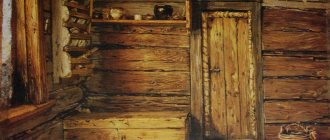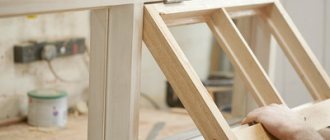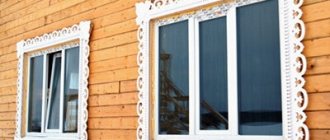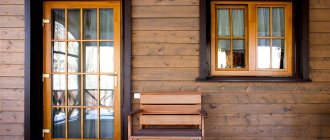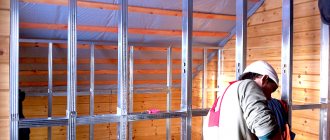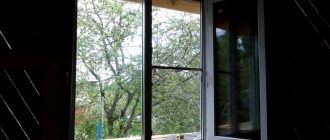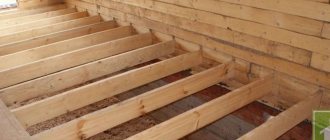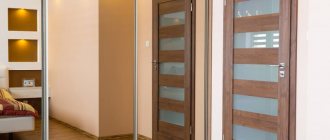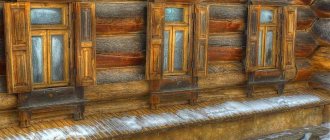They fit well into the existing facade, and their characteristics are many times superior to old Soviet-made wooden frames.
Modern wooden windows, although they do not have such disadvantages, are still very expensive in price and cannot always compete with metal-plastic ones in terms of operating conditions.
Is it possible to install in a log home?
Both experts and many years of experience in operating such window structures in wooden buildings speak in favor of their installation. However, this technology is more complex and different from installation in masonry walls.
This is explained by the fact that wooden houses from the moment the frame is erected, over the course of 2-3 years of operation, experience significant shrinkage.
In addition, this process can be repeated periodically, with fluctuations in the level of groundwater and frost heaving forces.
Therefore, unlike block and panel residential buildings, before installing such window blocks in a log building, thorough preparation must be carried out .
To protect the PVC frame from deformation during wall shrinkage, a casing/frame is pre-installed, which takes on all the vertical and horizontal loads of the load-bearing walls. In addition, a compensation gap is made at the top and bottom of 12% of the height of the new block.
Important! For old wooden houses where the shrinkage process has stopped, the compensation gap is made smaller.
Requirements for the installation of PVC structures in a log house
Installation of PVC windows is a responsible job, since the creation of normal living conditions in the house and the safety of residents depend on its quality.
For this purpose, dozens of regulations have been developed that regulate all working stages, starting from the production of materials for the production of window units, manufacturing technology, storage of finished products, their delivery to the site, as well as installation and operation of such a window in a wooden structure.
The main regulatory documents that all participants in the process - block manufacturers, installers and owners - must take into account:
- SanPiN No. 2.1.2.2645.10 - living conditions are established: according to internal air temperature, relative humidity and maximum noise level.
- GOST No. 30674, published in 1999, defines the basic design requirements for windows.
- GOST No. 23166, published in 1999, defines the conditions for the manufacture of PVC windows.
- GOST No. R 52749, published in 2007, requirements for installation seams of PVC windows.
- GOST No. 30971, published in 2012, has the most complete information on the installation of PVC windows.
- SNiP No. 23-02, published in 2003, defines the conditions for the energy efficiency of a window unit.
Basic GOST requirements for the installation of metal-plastic windows in wooden wall openings:
- The window frame should be smaller than the window opening: 4 cm in width and 7 cm in length.
- The horizontal error cannot be higher than 1 mm per 1 m of frame length.
- The use of foam is prohibited for fastening, only mechanical fasteners.
- Substantial requirements are placed on the assembly seam; a waterproofing protective membrane is placed on the outside, and a heat-insulating layer on the inside.
Important! GOST also imposes special requirements on the location of the window frame in the thickness of the wall; it is determined by the designer based on the material of the walls of its construction and the calculation of isotherms.
Standards for the location of PVC windows in the wall of a wooden house, depending on its multi-layer structure:
- Single-layer walls - 2/3 of the opening depth from the outer plane of the wall.
- Prefabricated walls - 1/2 the depth of the opening from the outer plane of the wall.
- Insulated walls made of logs with an insulating layer in the middle of the structure - on the line where the insulation is installed.
- Log walls - 2/3 of the opening depth from the outer plane of the wall.
- Log walls with external insulation - the window is installed as close as possible to the outer plane of the wall, directly with the insulating layer.
When installing external insulation on a wall, the preferred option is the method of deposition of the frame, when it partially protrudes beyond the plane of the wall and is covered with insulation along the entire perimeter.
Types of windows
For the purpose of installation in a timber building, wooden windows are most often used, although if desired, you can choose plastic ones. Both designs will last for many years, and installation is almost the same. However, they have their differences.
Wooden windows are characterized by a high level of environmental friendliness. They blend beautifully with the overall appearance of the house and fit into any interior. They are quite attractive in price. The disadvantages include the need for regular additional treatment with special means after 5 years of operation. This will prevent deterioration in the appearance of the material and its rotting. For the manufacture of frames, pine, oak or larch (in the form of laminated veneer lumber) are usually used.
Plastic windows let in less cold in the winter and have good thermal insulation and tightness. They are presented in many models on the market, which makes choosing the ideal option quite easy. Plastic is easy to maintain, resistant to impacts and does not lose its properties when used in unfavorable climatic conditions. The main disadvantage is considered to be low compatibility with the appearance of a house made of timber. And a low-quality design can retain heat poorly, significantly transmit sound from the street and have a short service life.
Windows also differ in their design. The installation process for them is identical, but operation can differ radically. The issue of choice should be approached as seriously as possible.
Single leaf
The smallest of the classic windows are single-leaf windows. They are ideal for a hallway or kitchen, but for other rooms the amount of light transmitted will be insufficient. Therefore, they should be inserted only in small areas.
Bivalve
Standard windows that are used in most apartments and private houses. They have two doors, one of which opens in both planes. They are distinguished by practicality and the highest levels of convenience.
Tricuspid
Ideal for large rooms. Fits best in the living room and bedroom. Windows let in a lot of light and make the interior more beautiful. Two of the three doors can be opened completely or at a certain angle.
Deaf
Fixed-type windows have the simplest design and are very small in size. They are designed for installation in basements or attics. The design does not imply opening, and its shape can be triangular, rectangular or round.
What is a socket and casing?
This is a damper structure to protect the PVC window frame from shrinkage processes in a wooden house. It is installed along the inner perimeter of the technological opening of the wall and consists of 2 sidewalls, a top and a window sill. The edges of the structure are secured using the tongue-and-groove method.
Important! Experts believe that such casing need not be installed in the walls of frame houses, since their window openings are already designed with a margin of strength and rigidity, and do not shrink.
Tips for choosing acceptable material for the pigtail , based on climatic conditions, moisture resistance and GOST requirements:
- Only dry board 50 mm and timber 50x50 or 150x100 mm are used.
- The width of the beam is assumed to be equal to the wall thickness.
- For panoramic glazing or installation of large balcony blocks, reinforced casing with a width of over 90 mm, made using adhesive technology, is used.
- The technological gap between the frame and the wall of the building in the window opening cannot be sealed with construction foam; experts advise using only natural insulation materials: tow and moss. It is also unacceptable to lay them very tightly, much less compact them, interfering with the natural movement of the structure.
Why is it needed in old and new timber buildings?
All wooden houses are very susceptible to shrinkage, not only from the use of wet wood, but also during seasonal processes of soil mobility. As a result of the influence of such external and internal factors, the dimensions of the box change, and quite significantly.
Shrinkage dimensions of a wooden house depending on the wall material:
- Regular log - up to 100 mm.
- Rounded log from 80 to 100 mm.
- Timber with natural humidity - no higher than 60 mm.
- Profiled timber - no higher than 50 mm.
- Kiln-drying profiled timber – approximately 25 mm.
- Glued laminated timber – no higher than 20 mm.
Important. To compensate for these loads in a log or timber house, when installing PVC windows, a protective structure is installed - a casing/frame, which protects the window frame from deflection and distortion, thereby guaranteeing the independence of window structures from the behavior of external wooden walls.
What varieties are there?
In practice, several types of casing are used for wooden walls:
- With embedded block . A special groove is made in the wall on the sides, where the embedded beam is inserted, the joint is insulated and sealed with flax fiber. Advantage: the most popular version of the pigtail, ease of execution, low price, high production speed. Disadvantages: average level of protection.
- U-shaped into a deck .
First, a guide pin for the box is made at the ends of the walls. Grooves are made in the vertical posts, the top is secured to the sides with self-tapping screws, and the window sill is secured with special wooden nails. Advantages: Very reliable, time-tested protection option, high heat-shielding characteristics, durable design. Disadvantages: high labor costs and price, complexity of work, requires the involvement of specialists. - T-shaped into a tenon , an option similar to a U-shaped pigtail: a groove is cut out in the box according to the size of the tenon on the sides, the top and bottom are attached in the same way as a U-shaped pigtail.
Advantage: a modernized version, imitates a window quarter of a brick house, high-quality connection and reliable protection. Disadvantages: high price, complexity of work, requires the involvement of specialists.
Necessary preparatory steps
Before planning the installation of windows, it is necessary to consider what type of material the building is built from . This is very important, because if profiled or sawn timber was used during construction, then such a building must “settle.” The need for such “sludge” at home is dictated, first of all, by the high level of moisture in the wood. The optimal period is usually 2-4 years. It is because of this that plastic windows are not installed in such houses immediately while shrinkage is taking place. Instead of them, temporary ones made of wood are installed.
It’s another matter if the building was erected using laminated veneer lumber. The moisture content of this material is low, and therefore, immediately after covering it with a roof, you can begin work related to the installation of PVC structures.
Important! In all cases, light-transmitting structures should not be installed on a layer (both above and below) made with polyurethane foam, otherwise there is a high probability of misalignment of the mounted products.
It should be remembered that even such timber, due to the properties of wood, is prone to slight deformations. The changes are especially pronounced after rain and in winter: in the first case, it swells, in the second, on the contrary, it shrinks.
Rules for measuring the opening
Wooden wall openings do not have protrusions like stone ones.
The PVC frame is placed on the same level as the wall , so the developer will not need to additionally finish the slopes from the facade of the house.
The technology for measuring wooden openings for installing PVC windows is extremely simple.
The width and height are measured at three points along the casing and the smallest indicator is selected, then 40-70 mm is added to it. If there is a box in a wooden wall, then the internal characteristics are measured.
Measurement example:
- Width: 172, 174, 170 cm, choose profile width 170-4=166 cm.
- Height: 124, 122, 120, choose profile height 120-7=113 cm.
Important! When determining the height of the profile, it is important to make sure that the structure, together with the sweet clover, to which the ebb on the outside and the window sill at the bottom are attached, fits unhindered into the opening.
To determine the size in the old opening, first remove the trim. When measuring at the ends of the logs, you need to take into account the size of the tenons protruding 2-3 cm, otherwise the PVC window will not be able to fit into the opening. When replacing a double-glazed window in a wooden house with a new one, you will additionally need to measure the thickness of the frame, the number of chambers, the thickness of the glass and the gap between the glasses.
Specifics of installing plastic windows in a wooden house
Plastic windows look quite attractive in a wooden wall. However, when installing them, it is necessary to take into account at least 3 important features:
- Shrinkage of wall material.
- Problems that arise when installation technology is not followed.
- Accumulation of dampness in the window environment.
Let's look at the specifics of each aspect in more detail.
Tree shrinkage - what needs to be taken into account, important nuances
Due to its specific structure - the ability to retain moisture in the fibers - wood is distinguished by pulsating dimensions. Even well-dried pieces dry out and decrease in size over time. Therefore, the opening in a wall made of timber, logs or boards will become smaller after a certain time.
On average, a one-story structure decreases by 2-6 cm in the first 2-3 years after construction. In addition, seasonal changes in air humidity can to some extent restore the original size of the structure. This property must be taken into account when installing plastic windows in a wooden house.
To compensate for shrinkage forces, a gap is left above the window Source stroyfora.ru
Otherwise, the window frame will be subject to bending, torsion and skew loads, which will significantly shorten its service life and subsequently require repair or complete replacement. This problem can be avoided by using a special installation technology, the main element of which is the casing system.
Problems with incorrect installation
In order for the installed window to operate normally, it is necessary to avoid the following series of errors during the installation procedure:
- Installation of the frame without preliminary manufacturing of the casing. As a result, the window becomes deformed and jams due to the pressure of the wall material during the natural shrinkage of the wood.
- Filling horizontal seams between the box and the wall with construction foam. When frozen, the filler is characterized by sufficient rigidity. Therefore, deformation forces will be completely transmitted to the window and destroy it - even if there is a properly equipped casing system.
Attaching a PVC window to foam is allowed only to the casing, and not to the wall of the house itself Source jurnalstroy.ru
- Incorrect ratio of frame dimensions and window opening. If there is no installation gap, the opening will have to be widened, and if it is excessive, the slopes will freeze, so additional insulation will be required with the installation of an expansion profile.
- Application of foam without protection from the street. When exposed to water and light, the material will degrade over time. This can be avoided by installing a protective strip of the PSUL type on the outside.
- Incorrect arrangement of hydro-vapor barrier of the gap or its complete absence. As a result, the material and parts of the wall adjacent to it will become damp and collapse.
- Installation of the frame is not level. The rules for installing plastic windows in a wooden, brick or concrete house are the same - horizontal and vertical elements must lie strictly in the corresponding planes. Otherwise, the fittings will be constantly overloaded and quickly deteriorate.
- Placing the frame in the area where negative temperatures penetrate the wall. As a result, condensation will always accumulate on the inside.
Freezing of a plastic window is the result of improper installation Source stroi.tv
Note! There is a widespread belief that when replacing old windows with new ones in a house that has been in use for a long time, there is no need to leave an installation gap and make a siege. In fact, even well-dried wood easily swells and then dries out again, constantly changing its size and putting pressure on the frame, under favorable conditions for this, for example, seasonal or absolute changes in air humidity.
Pitfalls - moisture accumulation
Tightness, high-quality heat and sound insulation – these are the main parameters that PVC window manufacturing companies often use to advertise their products. However, these positive properties have a downside - the lack of natural ventilation, characteristic of wooden unsealed frames.
This contributes to the accumulation of excess dampness, if not in the entire room, then at least near the window. The problem is solved in two ways:
- The operation of general ventilation systems in the house. However, if it is not there, then its installation will cost the owner an additional round sum.
- Arrangement of supply channels. Ventilation is formed after replacing the standard seal with special profiles.
The formation of condensation is a negative consequence of the tightness of a plastic window Source mirnadivane.ru
Important! Almost no installation company gives a standard guarantee for the installation of windows in a timber or log house. This is explained by the unpredictability of the behavior of wood, and, as a consequence, the impossibility of 100% compliance with the correct operating conditions of the window.
See also: Catalog of companies that specialize in doors, windows and related work
Choosing a Eurowindow model for timber walls
First of all, the developer, when choosing PVC windows, must pay attention to the quality of the product. All Euro-windows, both Russian-made and Western brands, must have a certificate of conformity of European quality - DIN EN ISO 9001 .
Products with such a document undergo special control, so their characteristics correspond to the highest production standards.
Basic recommendations for choosing PVC windows for wooden residential buildings:
Heat resistant frame.- Noise protection of at least 49 dB.
- The right double glazing is energy efficient.
- The number of chambers is at least two-chamber, preferably three-chamber with an operating temperature of 50 C.
- Low-emissivity glass with silver ions protects against heat in summer and frost in winter.
- For the private sector, especially for windows located on the 1st floor, it is recommended to install stain-resistant double-glazed windows that can change the level of transparency.
- The optimal distance between glasses is from 16 to 24 mm; outside this range, the thermal and noise insulation characteristics drop sharply.
- The width of the chambers and the thickness of the glass should be different, which increases the soundproofing characteristics.
- The chambers must be filled with an inert gas, such as argon, to prevent internal thermal convection.
- For anti-vandal and anti-burglary protection, the outer glass must be made using triplex technology.
- The size of the PVC window depends on the facade solution. According to the regulations, the developer must ensure a ratio of 1 m2 of glazing per 10 m2 of house area.
- The opening option can be rotary or tilt-and-turn. Large windows may have a sliding opening option. Windows with decorative layouts look impressive in a wooden house.
- Fittings affect the functionality of the window and its service life; it is better to purchase windows with fittings from European reliable brands, for example, German GU kits.
Checking products before installation
To avoid problems and unexpected unpleasant surprises during the installation process, it is important to first check the readiness and completeness of the products that the manufacturer must deliver to the installation site. If the delivered products are found to have obvious defects during visual inspection, they must be returned.
If the customer removes finished windows from the manufacturer’s premises using his own resources, then this check must be carried out at the place where the products are manufactured. As a rule, the company’s managers themselves offer to do this, so that the customer can then sign the work completion certificate stating that he has no complaints about the quality of the products.
The measurement results are indicated in the measurement sheet
It is necessary to check the dimensions indicated in the act and, for reliability, compare them with the dimensions in the measurement sheet . A copy of it is given to the customer along with the contract, which sometimes specifies maximum permissible deviations. If there is a discrepancy, the document is not signed and the product is given to the manufacturer for rework.
If everything is normal with the dimensions, then the next step is to check the plane of the product - it should be flat, without bends or deformations. The window system is delivered assembled, so it is important to check the sash control mechanism. Then the integrity of the glass unit and the density of the sealing elements inside are checked.
What to fasten with?
This type of work does not require complex expensive tools.
Note. If you do not have the necessary power tools, it is more profitable to rent them for a short period, since the entire work will not take more than one or two working days.
Basic tools, equipment and auxiliary materials that will be required to install Euro-windows in wooden frames:
- mechanism for gripping double-glazed windows;
- jigsaw;
- electric drill with drills for metal and wood;
- regular and rubber hammer;
- screwdriver with replaceable heads;
- set of hex keys;
- handle with hexagonal tip for removing pins;
- universal adjusting key;
- wedges and gaskets for installation;
- measuring tools: level, square, ruler and tape measure;
- a clamp with a wide grip for securing materials during cutting;
- fasteners;
- casing board;
- flax batting for thermal and noise protection of side seams in the casing;
- insulation and waterproofing tape for thermal protection of large seams;
- galvanized self-tapping screws for fastening the casing;
- linings;
- sealant.
Important! In the case where only one person will install a PVC window in wooden openings, a set of mounting slings will be required to lift and fix heavy frames in the window opening.
Required Tools
Before installing windows yourself, you should think in advance about having all the necessary tools.
You need to prepare:
- perforator;
- drill-driver;
- hammer;
- mallet;
- chisel;
- anchor plates;
- pliers;
- hexagon;
- level;
- polyurethane foam;
- spray bottle with water.
When replacing a tool with its analogue, special care should be taken, since the process of performing the same action in this case may vary significantly. You need to try not to make mistakes.
How to protect the frame?
In order to install the pigtail using the “into-a-block” method, you will first need to cut a groove in the openings in order to insert a 50x50 mm block into it through the insulation. A dry casing board 150 mm wide and 40 mm thick is attached to it with self-tapping screws.
This is a rough casing design, which consists of 2 side parts and a top. This design does not initially involve the installation of a window sill board, but experts still recommend installing it rather than subsequently attaching the windows to a log.
There should be a shrinkage gap of up to 5 cm at the top . The PVC window in the rough casing is installed on a stand profile, on building plates or self-tapping screws. The PVC window sill is placed under the stand profile.
The U-shaped casing is the most difficult to produce, but it is a more reliable option for installing a Euro-window in a wall opening made of wood, since it has a reverse quarter. This option is especially preferable for boxes made of timber and logs.
The process starts with the preparation of a 50x50 mm tenon , then a groove is selected on the side walls using a hand router, it is made a little more by 5 mm than the tenon, then the reverse quarter and lower locks are removed, for which the grooves are selected in the same way.
They begin to work on the top, first removing the back quarter from it, and then the locks. Try on the received parts, they should be inserted tightly, but without effort; effort will be required after installing the jute.
Reference. The finishing casing is one that will not be covered by a casing; it will need to be sanded after installation.
The T-shaped tenon socket is a very simple manufacturing option; even novice carpenters can do it.
Technology for installing a T-shaped frame into a tenon for a PVC window:
- Indivisible T-shaped sidewalls are cut out, having a tenon 50x50 mm and with a width equal to the thickness of the walls.
- Mark and select a groove for the sidewall tenon using a circular saw.
- The groove is made larger than the tenon both in depth and width by 5 mm.
- The window sill is made with a groove for the wind spike.
- They check and adjust the received ones without installation in the window opening.
- First, the bottom is laid, the sides are secured to it, and then the top is fixed.
- All parts must be installed tightly, but inserted into the grooves with little force.
Making a pigtail
First, you need to decide on the width of the frame bars: it should either be equal to the thickness of the wall, or be a little larger, so that later, when installing external trims, they (the trims) fit tightly and unhindered on the frame, and not on the wall. There is another option in a log house - a groove around the opening along the width of the groove.
Secondly, to make a pigtail you need to take well-dried material, otherwise the assembled structure itself will soon deform as it dries.
First we cut out the bottom part (window sill), making it 10 cm longer than the width of the opening. At the ends of the window sill we cut a groove for a tenon 65 mm wide and 40 mm deep.
We also make small 20 mm recesses at the ends of both window sills for joining the crossbars with the side posts - the so-called locks.
We make the side posts 70 mm higher than the height of the plastic window frame. On the reverse sides of the racks, using a circular saw, we cut out a groove for a tenon 60 mm wide and 40 mm deep. We immediately make a lock in the side posts for the upper part.
Lastly, we make the top part of the pigtail. Based on the dimensions obtained between the two installed side parts.
How to install and secure - operating technology
In principle, this installation technology follows the same rules for all wooden boxes. There are some small nuances when installing in frame houses, timber and log buildings.
Experts believe that it is most difficult to install Euro-windows in wall structures made of rounded timber . This is due to the different amount of timber shrinkage from 8 to 15 cm, which depends on the manufacturer.
It is advisable to install PVC windows in chopped boxes made of profiled/planed logs or profiled beams; after the main shrinkage of 1.5-2 years, only using sliding joints, the PVC window should move separately from the wall structures.
Important. Windows in houses made of laminated veneer lumber and frame buildings are allowed to be installed immediately after the walls and roof are assembled.
There are restrictions for timber and log houses regarding external decoration:
- On top of the pigtail, a reserve for shrinkage is required - 7 cm, which is filled with tow.
- Platbands, slopes, both internal and external, are fastened with nails not to the timber, but to the frame.
The nuances of installing metal-plastic windows in frame-type buildings:
The key points when arranging such a window are to correctly design the installation seam located between the frame posts and the PVC profile.- The installation seam must be three-layered: the outer one protects the insulation from the effects of precipitation and wind, the central one for noise and heat protection, and the inner one from household moisture.
- The window installation line in the frame opening is the location of the insulation.
- During installation, it is mandatory to use a stand profile.
Step-by-step instructions for installing plastic window systems in a wooden house:
- After securing the casing, they begin to disassemble the PVC window.
- Remove the glass unit from the opening frame, move the handle to the open position without opening the sash, remove the upper hinge rod, only after that the sash is opened and removed from the lower hinge.
- Remove the side beads on the “blind” sash, bending them with a knife towards the double-glazed window and back, after which they snap off, then remove the upper and lower ones, holding the double-glazed window.
- When removing the glass unit, wear gloves to avoid cutting yourself on sharp edges.
- Mounting holes are made in the frame for fastening with a 6x70 drill with a gap of 150 mm from corners and imposts and 700 mm from each other on straight sections.
- Place PVC mounting pads under the corners and impost and level their horizontal/vertical alignment with a building level, while the PVC frame should not rest against the casing, the minimum gap is 1 cm.
- Start installing the fasteners; you don’t need to tighten them too much, since you can break the strict verticality/horizontalness of the structure.
- Foam the gap between the PVC frame and the casing.
- Mount the window sill level, using mounting plates, securing it with self-tapping screws at the bottom of the window frame.
- Install the ebb.
- Install the adjustment plates of the drain holes, making sure that the glass unit does not block them.
- Carefully install the double-glazed window into its place in the frame; it should not fit very tightly between the racks, so that due to temperature expansion the window frame does not warp.
- Strengthen the glass unit with glazing beads, lightly tapping them with a rubber hammer until it clicks.
- After the window is installed, they begin sealing the seams and finishing work on the slopes.
Important! It is not recommended to foam large installation joints with mounting foam; it is better to use natural heat insulators, moss or mineral wool. Because the foam keeps the logs from shrinking, which will cause additional deformation of the window block.
After completion of the shrinkage processes in the house after 1-2 years, the pigtail can be additionally secured with both metal fasteners and foam.
How to do the finishing yourself?
Finishing work on a PVC window in a wooden opening includes the installation of trim, slopes and drainage.
On log, timber and frame walls, both wooden and PVC slopes look harmonious .
The contractor must wait until the installation seams harden, remove excess foam if any joints were treated with it, install insulation in the slope area and glue the vapor barrier tape.
From the outside, windows are installed with drip and decorative covers on the openings used to drain condensate liquid. The gaps between the frame and the walls are covered with decorative platbands.
Important! It must be remembered that all finishing elements: ebbs, slopes and platbands are attached in timber and log houses exclusively to the casing with finishing nails.
For interior decoration, the list of available materials is more voluminous and varied, since operating conditions do not imply exposure to aggressive natural factors. It includes: natural and plastic lining, cashing and MDF panels, which have a wide selection of shapes and colors.
Setup and operation
After the main installation work has been completed, we proceed to checking the functionality of the PVC window and setting it up.
The main types of setting up a PVC window block in a wooden household:
- Vertical/horizontal adjustment of the valve geometry. For vertical adjustment, adjust the hinges from below; to do this, remove the overhead protection, freeing the adjusting screw; to lift the sash, turn it clockwise.
When adjusting the horizontal position, you will need to adjust 2 hinges; on the side there is a screw that regulates the horizontal position, turning it “from left to right” brings the sash closer to the hinge.It is important that a gap of 2-3 mm remains between the hinge and the sash, otherwise the tight waist will not allow the user to install the PVC window in ventilation mode. The upper side adjustment screw presses the upper corner of the window harder.
- Adjusting the anti-burglary plate of the pressure lock by adjusting the mushroom-shaped pin; when moving it clockwise, a tongue should extend, ensuring the tightest possible clamping of the sash to the frame.
- Adjust the pressing force of the upper corner, open the window in 2 directions, set the blocker, set it to ventilation mode, pulling the upper edge of the sash towards you, determine the location of the pressing mechanism, and adjust the degree of pressing of the corner.
Construction of plastic products
The components of metal-plastic windows are:
Frame. This is an important part that carries out the main function of the structure—ensuring rigidity and tightness. The plastic profile from below is reinforced with a steel profile and fastened to it with self-tapping screws. It is welded at the joints in the factory;
Sash. It provides air access to the room and its restriction. Plastic gives it an aesthetic appearance, and the reinforced steel profile strengthens it, makes it strong and durable;
Accessories. It includes elements and mechanisms that facilitate closing and opening the window sash:
Accessories clearly
- Handle lock, which helps to hold the open window at an angle;
- Locking rollers. They press the sash against the frame;
- Involuntary closing blocker. It prevents the sash from closing from a draft;
- Tilt and turn fittings allow you to install the sash in 4 positions.
Double-glazed window. It is part of a window block that allows light to pass through. It includes 2-3 glasses. The chamber between the two glasses is filled with gas;
Glazing beads. They secure the glass to the frame;
Rubber seals. They are necessary to ensure the tightness of the structure;
Impost. This is a plastic profile, inside of which there is a reinforced steel pipe. It serves as a connecting element between the parts of the window;
Shtulp. It is located on the sash.
Sectional window
How to insert and make a replacement without errors?
The most difficult process of installing PVC windows is for timber and log houses, which have a maximum shrinkage percentage.
Important . The biggest mistake in installing window systems in such houses is direct installation of the frame on the timber, without the use of casing.
The main mistakes that developers make when installing PVC window systems in wooden load-bearing walls:
Poor sealing of installation seams with natural insulation materials, in places of connecting seams between the wall, casing and frame.- The design lacks an insulated window sill and an external ebb.
- Lack of insulated internal and external slopes.
- Inconsistency of the horizontal/vertical level of the frame structure.
- Poor adjustment of window fittings.
- The glass units were not sealed after assembly.
Possible problems if windows are installed incorrectly
Switching winter - summer
Avoiding lengthy discussions on the topic “which windows are better to install so that the savings are truly economical,” let’s formulate a simple rule: any window, even the most expensive, will not provide the declared characteristics if it is installed incorrectly.
Therefore, in addition to strictly following the above recommendations, you must avoid the following mistakes:
- incorrect position of the window according to the thickness of the frame. The consequence of the error is freezing and condensation. For classic wooden houses, windows are installed along the center line. In cases where the house is lined with brick or lined with thermal insulation, we recommend contacting specialists to calculate the position of the window;
- lack of seasonal adjustment. The consequence of the error is a violation of air exchange standards. In those windows where this is possible, adjustment is performed using splines placed in the desired position.
accepts orders for finishing, repair and restoration of log and lumber buildings, including installation or replacement of windows. You can clarify the details of cooperation and order a surveyor’s visit by contacting our specialists using any of the communication methods published on the “Contacts” page.
Calculate the cost of painting and insulating your home right now
Select types of work:
Select materials:
Advantages and disadvantages
Installing energy-efficient PVC windows is absolutely the right solution for wooden houses of any modification. The advantage of this choice :
- High heat, moisture and noise protection.
- A wide range of sizes and colors, for example, laminated wood.
- The durability of the external design does not require annual painting of the frames.
- Energy-efficient and impact-resistant double-glazed windows.
- Multifunctionality.
- Low price.
- Long service life, more than 50 years.
Minuses:
- Large shrinkage of the walls, the need to use casing.
- High cost and complexity of installation work, which can only be performed by specialists.
- Large amount of thermal insulation.
Cost of services
For those developers of wooden houses who will invite specialists to install PVC windows, it is better to order this work on a turnkey basis .
Then the cost of the work will include: window measurements, quality of wall openings, dismantling volumes, glazing size, block model and transport services.
Serious experienced companies, as a rule, offer customers installation options “Economy” - 2,000 rubles / set, “Standard” - 3,000 rubles / set and “Elite” up to over 5,000 rubles / set.
Note. For an additional payment, the customer can order the installation of window sills, ebb and flow and finishing of slopes.
The main types of work for installing PVC windows in a house with wooden walls:
- Installation of a roof window in an uncovered roof—RUB 4,000/set.
- Inserting a roof window into a covered roof—RUB 7,000/set.
- Cutting a window opening in a log house - 300 rub./l.m.
- Installation of a pigtail - 700 rub./p.m.
- Cutting space for a key 50x50 mm - 250 rub./l.m.
- Installation of a “Standard” window block - 3000 rub./set.
- Finishing of slopes - 300 rub./rm.
- Window cashing - 300 rub./p.m.
- Execution of additional work - 250 rub./p.m.
- Installation of wooden window sills - 400 rub./rm.
- Installation of wooden shutters - 2000 rub./window.
- Installation of ebb tides - 300 rub./rm.
